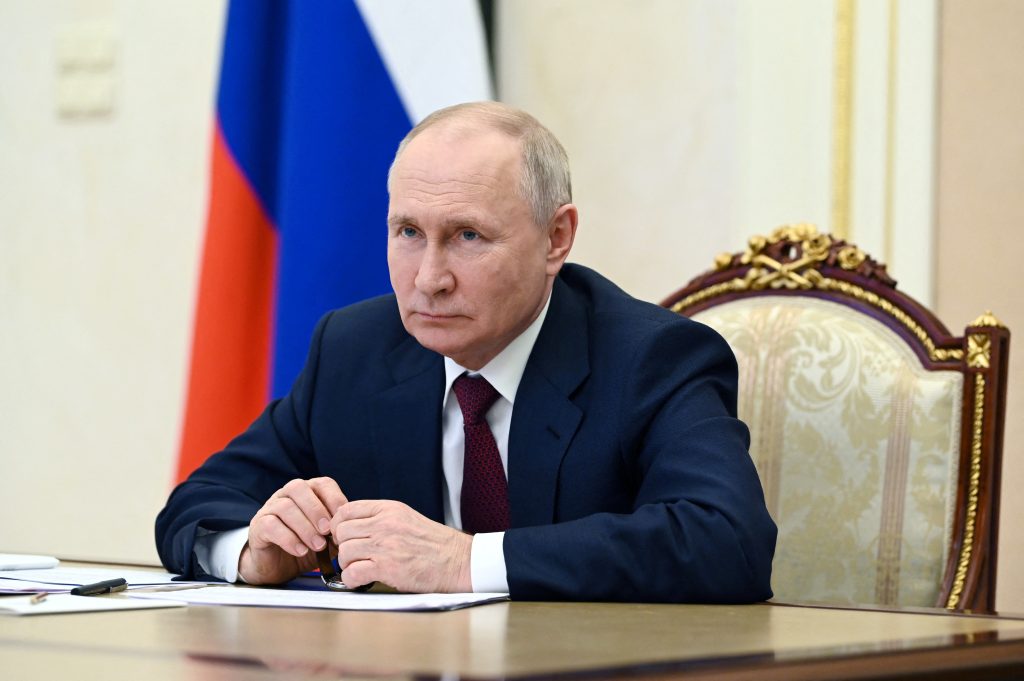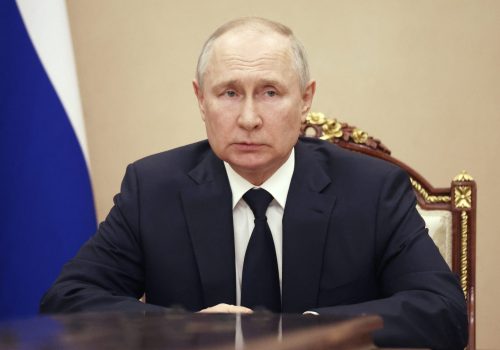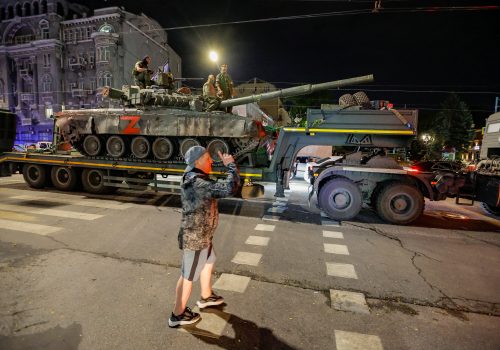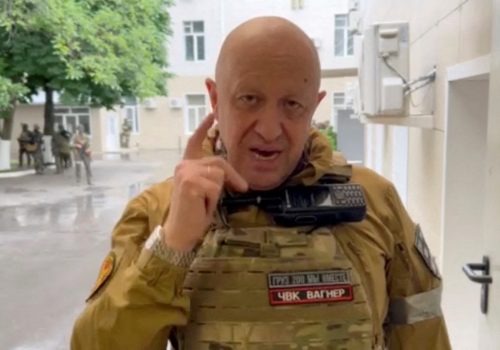This article was updated on July 6.
The extraordinary march of Wagner Group leader Yevgeniy Prigozhin’s forces to within a couple hours of Moscow ended abruptly on June 24. But Prigozhin’s decision to stand down and move to Belarus will not be the end of the story.
While the immediate crisis for Russian President Vladimir Putin may dissipate, what scenarios should US and allied officials prepare for in the coming days, weeks, months, and beyond? Here are four possible paths for Russia’s future.
1. A weakened Putin rules
Putin restores order and effectively reduces the ability of Prigozhin and the Wagner Group to challenge his rule. Prigozhin stays in Belarus with a diminished force, while other Wagner fighters go home or join the ranks of the regular Russian armed forces.
Nevertheless, even if Putin remains in power for the foreseeable future, the façade of order and stability that he has constructed over two decades in power has been shattered, with Russia’s would-be tsar showing himself to be vulnerable to competing actors. Quick action to sideline Prigozhin dissuades potential internal challengers from following Wagner’s example, but Putin still needs to pay extra attention to keep different oligarchical interests and power brokers in line.
Russia’s internal dynamics will also shape, and be shaped by, the war effort in Ukraine. Overcoming the mutiny and preventing severe immediate challenges to his authority allows Putin to refocus to some degree on the war effort.
In this scenario, Putin is better positioned to concentrate his security forces on preventing major gains for the Ukrainian counteroffensive. The rapidity with which the crisis was resolved, as well as the lack of successor crises within Russia, means that any effect on Russian soldiers’ morale is limited. Ukraine could still make some important gains in this counteroffensive, but its forces will receive less help from internal disarray in Russia.
The United States and its NATO allies see Putin as weak and potentially vulnerable, though they still must contend with him as Russia’s leader. Still, seeing his weakness, they are willing to continue supplying Ukraine and keep up the pressure on Moscow, with new weapons systems (e.g., long-range Army Tactical Missile Systems, or ATACMS) possibly on the horizon.
Meanwhile, a weakened Putin grows more dependent on China, further reifying Russia’s status as China’s junior partner. China does not want to lose its primary strategic partner, and this scenario offers Beijing greater predictability, insofar as it is able to continue engaging with Putin. Chinese leader Xi Jinping may take note of Prigozhin’s mutiny and consider threats to his, and his party’s, rule in China; however, he also could feel reassured by how quickly the crisis passed.
2. A new regime rises
In the summer of 1991, Kremlin hardliners attempted a coup against Soviet President and General Secretary of the Communist Party Mikhail Gorbachev. The coup failed, but Gorbachev was weakened and out of power by the end of the year.
In this scenario, Putin suffers a similar fate. The Prigozhin challenge is sidestepped for the moment, but Putin’s political position is irreparable and rapidly deteriorates. Internal competitors line up, consolidating strength and waiting for the right opportunity to strike.
Faced with internal threats, Putin is distracted from the Ukraine war effort and even has to reallocate security forces to deal with his competitors. At the same time, the counteroffensive picks up steam. Ukrainian forces break through weak points in Russia’s lines, retaking substantial ground and severing the land bridge that Russia has created by occupying Ukrainian territory from the Russian border to Crimea. Morale flags among Russian troops, and disgruntled soldiers stream back into Russia, angry with the country’s political leadership for sending them to fight a bloody, failing war.
At this point, Putin’s adversaries strike. Perhaps Prigozhin and the Wagner Group reconstitute in Belarus and conduct another march on Moscow. In addition, or alternatively, other nationalist forces take advantage of discontented troops to build their own miniature armies outside the purview of the state. Regardless of the precise mechanism, political and military elites turn on Putin, who is killed or forced into “retirement.”
Even though chaos appears imminent, a new regime consolidates power quickly, preventing a civil war and restoring order in a post-Putin era. The war in Ukraine does not end immediately, but the exigencies of establishing order reduce the likelihood of any significant new Russian offensives in the near or medium terms, and the new regime instead focuses on salvaging some gains from the war while maintaining stability at home.
The United States and NATO adjust to this new reality, sizing up a new authoritarian regime. There might be an opportunity to ease tensions if a long-term peace agreement or ceasefire is reached in Ukraine, though a comprehensive thaw in relations is unlikely. Tough talk about the West may continue in propaganda outlets, but Russia’s weakened conventional military forces undermine its credibility to present a hard-power threat to NATO allies. Still dealing with the aftereffects of a power transition at home, the new regime is disinclined to conduct provocations abroad and instead could seek stability in its relations with external powers. Nevertheless, the behavior of the new Russian leadership is not wholly predictable, and NATO prepares to deter and defend against potential acts of aggression by the new regime.
This scenario presents unwelcome uncertainty for China, which must navigate relations with a post-Putin regime. The new regime may remain generally aligned with China, recognizing its need to rely more heavily on its foremost strategic partner. On the other hand, absent the strong Xi-Putin partnership, it is plausible that the new leadership chafes at being the junior partner vis-à-vis Beijing and the relationship between the two countries weakens, albeit while retaining a common distaste for the United States.
3. The tempest arrives
As in the previous scenario, there is a temporary pause in tensions, followed by a descent into civil war. Putin’s adversaries are emboldened by his apparent weakness, which is exacerbated by a deteriorating situation on the battlefield in Ukraine. In this case, however, no competitor is strong enough to consolidate power.
Russia fractures into competing power blocs. This could mean Putin retains power and loyalists in some parts of Russia, even as Prigozhin and nationalist leaders develop quasi-fiefdoms elsewhere. Further complicating this scenario would be the rise of secessionist movements that further divide Russia.
As one of the United States’ foremost geopolitical competitors fragments, this scenario raises other questions.
For example, what happens to Russia’s nuclear weapons? Russia has thousands of nuclear warheads, and a civil war opens up opportunities for different actors to take advantage of the chaos and access those weapons. Eager to avoid this proliferation, the United States and NATO seek to contain the civil war within Russia’s borders.
As for the war in Ukraine, an enduring civil war results in Russian lines quickly collapsing as command-and-control disintegrates. Competing power players vie for the loyalty of embittered but battle-hardened soldiers returning to Russia.
This scenario is particularly bad for China, as it witnesses its premier strategic partner reduced to disarray. Moreover, it compounds China’s regional nuclear proliferation concerns, while also creating instability at its border and a potential influx of refugees. China now needs to allocate substantial resources to securing a lengthy border that it previously did not have to worry too much about. Russia’s energy industry also suffers, meaning Beijing cannot rely on Moscow as much to meet its exorbitant energy demands and must look elsewhere. Furthermore, in this scenario especially, Beijing might become even more cautious regarding an invasion of Taiwan as it witnesses the regime-threatening internal instability that can be wrought by invasions gone awry.
4. Reformers seize the moment
A final scenario worth considering is the possibility of a reform-minded regime coming to power in Moscow. As in the previous two scenarios, the temporary reprieve in tensions following Wagner’s mutiny gives way to renewed challenges to Putin’s rule, accelerated by a declining situation on the battlefield.
Putin manages to keep power through the March 2024 Russian presidential election, which is marked by fraud and widely recognized among the populace as illegitimate. In this case, a more democratically inclined opposition, perhaps associated with Alexei Navalny, seizes the opportunity and manages to cultivate sufficient popular support, with rallies and protests across Russia promoting change. Under intense pressure, Kremlin elites express sympathy with the reformers, and Putin ultimately decides to step down. A reformist leader wins the ensuing constitutionally mandated presidential election.* After assuming and consolidating power, the new government seeks a quick end to the war in Ukraine, while focusing on implementing anti-corruption and political reforms in Russia.
For the United States and NATO, this scenario increases the likelihood of Russia becoming a more responsible member of the international system and reducing military tensions between the Alliance and Moscow. That said, change will not happen overnight, and a reform-minded Russia will have to wrestle with deeply entrenched corruption and economic issues. China, for its part, finds this scenario disastrous, as it faces a nuclear-armed state on its border that is ideologically more sympathetic to the West.
These scenarios do not exhaust all possibilities, but they account for four plausible futures US and allied policymakers should consider in their strategic planning. A scenario in which a reform-minded opposition comes to power is the least plausible, as Russia has long proven resistant to extensive political reforms, and it is unclear that there is a movement sufficiently organized and with broad enough support to take advantage of a power vacuum. The first scenario is the closest to the status quo, and Putin has been remarkably resilient as a leader; on the other hand, Putin has also never appeared weaker, and external pressure wrought by Ukrainian success on the battlefield could help to facilitate his downfall.
Jeffrey Cimmino is the deputy director of operations and a fellow at the Scowcroft Center for Strategy and Security.
This article was updated to clarify the circumstances under which a reformist leader could come to power in scenario four.
Further reading
Thu, Jun 29, 2023
Putin’s Wagner weakness is a signal to support Ukraine’s counteroffensive
UkraineAlert By
With the short-lived Wagner mutiny exposing Vladimir Putin’s weakness for all to see, the time has come for Ukraine's Western partners to provide the country with everything it needs to secure victory, writes Taras Kuzio.
Sat, Jun 24, 2023
Experts react: What Russia’s Wagner Group rebellion means for Putin, Ukraine, China, and more
New Atlanticist By
How did Prigozhin’s rebellion get as far as it did? And how will its aftermath affect Putin’s hold on power and the war in Ukraine?
Sat, Jun 24, 2023
Russian War Report Special Edition: Prigozhin and Wagner forces mutiny against Moscow
New Atlanticist By
A special edition of the Russian War Report on Wagner Group's mutiny against the Russian military and occupation of Rostov.
Image: Russian President Vladimir Putin chairs a meeting with members of the government, via video link at the Kremlin in Moscow, Russia July 4, 2023.



